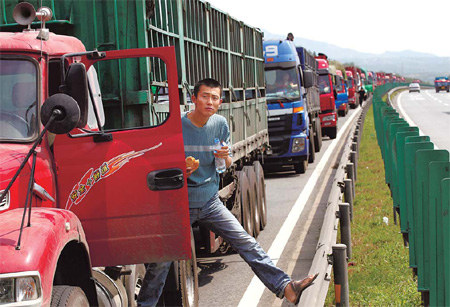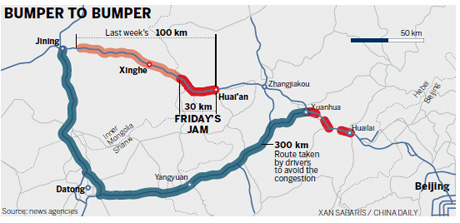Society
Monster jam puts brakes on again on N.China expressway
By Wang Qian, Cheng Yingqi (China Daily)
Updated: 2010-08-28 07:44
 |
Large Medium Small |
ZHANGJIAKOU, Hebei - A monster traffic jam that was soon snaking back 30 km brought traffic to a standstill on the Beijing-Tibet expressway on Friday - just four days after another recent logjam was broken.
|
 A driver takes his lunch while waiting in the long traffic jam on the Beijing-Tibet expressway on Friday. [China Daily]
|
The snarl-up was triggered by a car accident and road maintenance.
| ||||
The jam was the second serious holdup on the road in recent days. Other sections in Inner Mongolia, Shanxi and Hebei province have also experienced recent congestion.
The previous jam, which started on Aug 14, lasted nine days and trapped thousands of vehicles in a tailback that extended for more than 100 kilometers. That jam was caused by road maintenance work and an exceptionally large number of heavy trucks trying to use the road.
Lu Yong, a 37-year-old truck driver, was unlucky enough to have been stuck in both.
He told China Daily on Friday that he was stranded for two nights and one full day in the last jam - at almost the exact same location.
He broke free just four days ago with his cargo of 31 tons of Hami melons.
"Who knows when the traffic will move again?" the frustrated driver asked. "I should have prepared some food and drink."
Compared with the anxious Lu, Gao Yunming, a 32-year-old bus driver from Zhangjiakou, appeared much more relaxed, passing time by chatting with other drivers and eating deep-fried buns and meat.
Gao said he left home prepared for the worst and brought instant noodles, buns and drinks.
"It is no surprise for experienced drivers to see traffic jams on this highway and, if we are in a hurry, we choose other expressways that cost more to use," Gao said.
Many local merchants capitalized on the stranded drivers' predicament by offering food and drink at inflated prices. Local media reported that some even offered to show drivers a way around the traffic jam on the back roads - for a 50-yuan ($7) fee.
A China Post mail truck traveling from Hohhot to Beijing was among vehicles paralyzed by the jam.
Forty-four-year-old Jia Wensheng told China Daily he was worried because people were waiting for letters and packages.
Ironically, a traffic police car was also among vehicles caught in the tailback. It had been dispatched to help disperse traffic.
"There was a rear-end collision on the highway, but we cannot get over there," said a traffic policeman, who refused to be named.
Experts blamed the recent jams on fast urbanization and overstretched infrastructure.
Zhao Jie, deputy director of the Urban Transport Institute under the China Academy of Urban Planning and Design, told China Daily the nation's highways have to cope with fast and heavy traffic and increasing population demands.
"With fast urbanization, more urbanites are living on the outskirts at night while working in downtown areas during the day," Zhao said.
"Take Beijing for example, the city now has more than 4 million vehicles and traffic jams are becoming common."
He said the coming five to 10 years will be crucial in developing the capital's public transportation system. He said the authorities will need to continue the expansion of the subway system, create inter-city light rail routes and add buses to relieve the heavy traffic.
Tan Zongyang contributed to the story.



